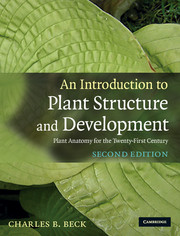Book contents
- Frontmatter
- Contents
- Preface to the second edition
- Preface
- Acknowledgements
- General references
- Chapter 1 Problems of adaptation to a terrestrial environment
- Chapter 2 An overview of plant structure and development
- Chapter 3 The protoplast of the eukaryotic cell
- Chapter 4 Structure and development of the cell wall
- Chapter 5 Meristems of the shoot and their role in plant growth and development
- Chapter 6 Morphology and development of the primary vascular system of the stem
- Chapter 7 Sympodial systems and patterns of nodal anatomy
- Chapter 8 The epidermis
- Chapter 9 The origin of secondary tissue systems and the effect of their formation on the primary body in seed plants
- Chapter 10 The vascular cambium: structure and function
- Chapter 11 Secondary xylem
- Chapter 12 The phloem
- Chapter 13 Periderm, rhytidome, and the nature of bark
- Chapter 14 Unusual features of structure and development in stems and roots
- Chapter 15 Secretion in plants
- Chapter 16 The root
- Chapter 17 The leaf
- Chapter 18 Reproduction and the origin of the sporophyte
- Glossary
- Index
- References
Chapter 11 - Secondary xylem
Published online by Cambridge University Press: 05 June 2012
- Frontmatter
- Contents
- Preface to the second edition
- Preface
- Acknowledgements
- General references
- Chapter 1 Problems of adaptation to a terrestrial environment
- Chapter 2 An overview of plant structure and development
- Chapter 3 The protoplast of the eukaryotic cell
- Chapter 4 Structure and development of the cell wall
- Chapter 5 Meristems of the shoot and their role in plant growth and development
- Chapter 6 Morphology and development of the primary vascular system of the stem
- Chapter 7 Sympodial systems and patterns of nodal anatomy
- Chapter 8 The epidermis
- Chapter 9 The origin of secondary tissue systems and the effect of their formation on the primary body in seed plants
- Chapter 10 The vascular cambium: structure and function
- Chapter 11 Secondary xylem
- Chapter 12 The phloem
- Chapter 13 Periderm, rhytidome, and the nature of bark
- Chapter 14 Unusual features of structure and development in stems and roots
- Chapter 15 Secretion in plants
- Chapter 16 The root
- Chapter 17 The leaf
- Chapter 18 Reproduction and the origin of the sporophyte
- Glossary
- Index
- References
Summary
Perspective
Most of the major taxa of vascular plants produce secondary xylem derived from the vascular cambium. Pteridophytes (except some extinct taxa), most monocotyledons, and a few species of largely aquatic dicotyledons, however, produce only primary vascular tissues. In woody plants secondary xylem comprises the bulk of the tissue in the stems and roots. It is the most important supporting tissue in arborescent dicotyledons and most gymnosperms, and the major tissue for the transport of water and essential minerals in woody plants. Secondary xylem is a complex tissue that consists not only of non-living supporting and conducting cells but also of important living components (rays and axial wood parenchyma) which, with those in the secondary phloem, comprise a three-dimensional symplastic pathway through which photosynthate and other essential molecular substances are transported thoughout the secondary tissues of the plant (Chaffey and Barlow, 2001; see pp. 206–207 for more detail). Additional increments of this tissue are added during each growing season (usually annually), but in older regions of most woody species only the outer increments are functional in transport although the number of increments that remain functional varies greatly among different species. Older increments gradually become plugged by the deposition in them of waste metabolites such as resins, tannins, and in some species by the formation of tyloses (balloon-like extensions of axial or ray parenchyma cells into adjacent conducting cells). The inner non-functional secondary xylem is called heartwood, the outer functional secondary xylem, sapwood.
Information
- Type
- Chapter
- Information
- An Introduction to Plant Structure and DevelopmentPlant Anatomy for the Twenty-First Century, pp. 184 - 221Publisher: Cambridge University PressPrint publication year: 2010
